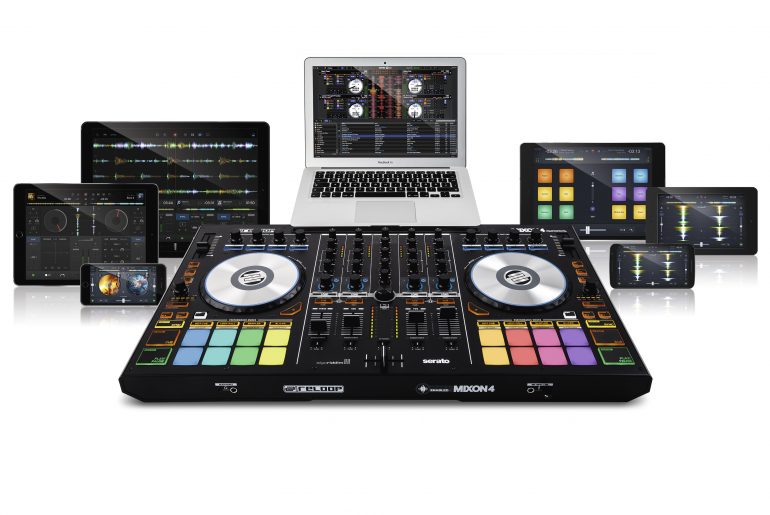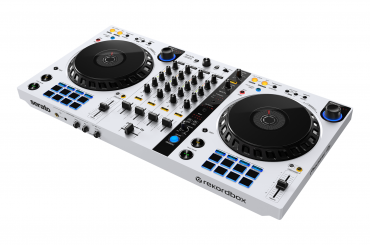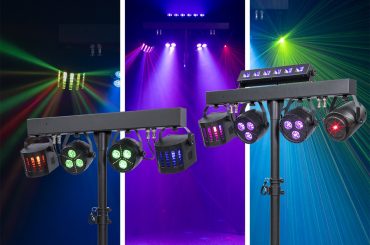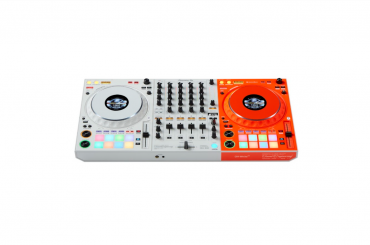This past January, during my annual trek to Anaheim, Calif., for the Winter NAMM Show, there were a few things on the exhibition floor that really caught my eye, and one of them was found at the American Music & Sound booth: The new Reloop Mixon 4 DJ controller.
I must confess, after many years of reviewing DJ controllers, it tends to take something special to really grab my attention, and that’s the very reason why the Mixon 4 stood out.
What’s so special? The answer begins with a slot on the top of the unit — one that serves as an easel for Android tablets and Apple iPads, up to the 12.9-inch iPad Pro model. The answer continues with the Serato and Algoriddim logos, both screen printed on the face of the unit. As you’ve guessed by now, the Mixon 4 is a hybrid, multi-platform, multi-software controller — one with even more tricks up its sleeve.
For those not in-the-know, Münster, Germany-based Reloop has been making music gear for only a couple of decades now – it’s distributed Stateside by Newbury Park, Calif.-based American Music & Sound. In addition to the Mixon 4, Reloop makes a very wide range of goodies for the DJ and pro-audio markets, and in fact, a review of one of the company’s new DJ mixers is on my task list as we speak. But I must give the company serious props for out-of-the-box thinking with the Mixon 4.
Tablet DJing Goes Pro: As an iPad Pro user myself, I was particularly interested in how the Mixon 4 worked with Algoriddim’s wildly popular app named, appropriately, “djay Pro” (leading lower case “D” intentional). It’s been nearly six years since I first looked at Algoriddim’s offerings, and back then, in my review, I stated: “Using an iPad to DJ was surprisingly fun, amazingly enjoyable, and shockingly effective. I’m not sure I can envision a professional DJ using their iPad for serious gigs.”
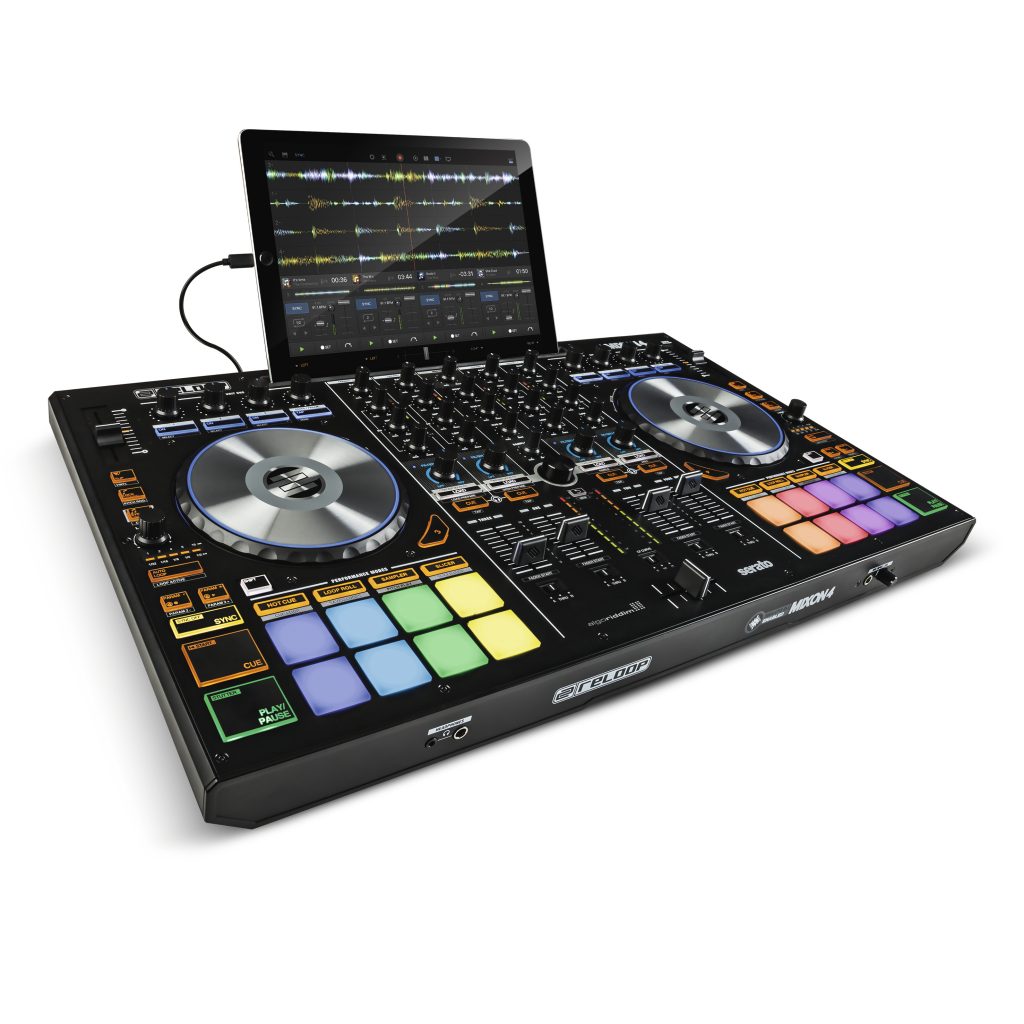
What a difference the intervening years have made, and I’m prepared now to eat those latter words. I must say that iPad DJing with the djay app and the Mixon 4 was, to use those same words, surprisingly fun, amazingly enjoyable, and shockingly effective. But as I said in 2011, it was essentially a window into the future, and the future is now. Reloop has brought iPad DJing to true professionals with surprising finesse, and as the technology has improved, I can’t see any reason not to go all-in on the concept. Perhaps the only drawback is getting your required music library physically onto the device, which on iOS, is more complicated than it should be compared to a regular laptop. (In contrast, users of most Android tablets will generally find that process pretty easy.)
Perhaps one of the most novel and useful elements of the combination of Algoriddim’s djay and the Reloop Mixon 4 is the former’s support for Spotify. Using Spotify APIs, djay unlocks a world of music that can supplement or replace locally stored material. With a paid Spotify account, you can tap into all the material the platform provides, along with your own playlists and the material within them. I can see this being incredibly powerful for mobile jocks in particular. At my most recent wedding gig, I’d created a Spotify playlist with all the client’s musical choices already reviewed, screened, approved and loaded across two iOS devices. I found it far easier (and cheaper) than purchasing soft copies of everything they wanted that I didn’t have in my library, and having a consistent method of accessing the material was a welcome change, too.
The downside in this case, however, is that djay and the Spotify integration it provides have no method of locally storing material, and locally stored music you might have within your Spotify app is not accessible to djay due to the architectural limitations of iOS. As a result, a live Internet connection is required. That’s probably available in most venues, and even smartphone tethering or using a “MiFi” unit will give enough bandwidth to power it. However, depending on Internet connectivity for a paid gig carries some risks, and may not be one you want to take. Spotify’s catalog limitations, especially in the EDM space, may limit options as well. But that being said, having it available, even if just as a supplement to more efficiently handle those random, unexpected music requests of guests, has a huge amount of value — as I discovered using the set-up at another gig.
Let’s Not Forget the Laptop: Of course, tablet DJing is not the only thing in the Mixon 4 playbook. As I mentioned earlier there’s a Serato label screen printed on the front of the controller, and the unit provides extensive feature support for Serato DJ — as well as bundling the full version of the software with the unit.
When used with Serato, I found it effective, familiar, and straightforward. Controllers designed for Serato largely follow a general design template, it seems, for core functionality. That means it’s easy to jump right in with the basics, while learning the unique capabilities of each set-up, and the Mixon 4 is no different. Transport controls are where you’d expect, and the 2-x-4 grid of rubber-like, backlit pad buttons are there, too, to provide access to cueing, looping, samples and slicing. Effects controls are fairly standard, as well – four knobs, four buttons. In combination, they let you select and control Serato’s excellent standard range of effects.
One handy feature, speaking of effects, is that the Mixon 4 has a combined LPF/HPF (low-pass and high-pass filter) knob on each channel, just under the tri-band EQ knobs. While I tend to prefer separate LPF and HPF controls, a single combo knob lets you do most of what you need in terms of filtering. Otherwise, the Mixon 4 makes a pretty standard, but quite capable controller for Serato users.
A Lot to Like: After using the Mixon 4 for a while with both djay Pro and Serato, I found a whole lot to like. The unit is solidly built, and the controls feels great — much as you’d expect for a controller in this price range (roughly $800 street price). Support for four channels is a plus, and it’s nice that Reloop provided separate gain controls for each channel. On the front, you’ll find dual-size headphone jacks, as well as a ¼-inch mic input with gain knob. On the back, the availability of both XLR and RCA jacks for output, and ¼-inch TRS booth outs as well, makes it suitable for truly pro environments. I also appreciated the ability to disable the crossfader — great for DJs like me who prefer to use the channel faders instead.
However, I did also find some drawbacks. Probably the biggest is that I found the platters to simply be too short. It was difficult to move them on their edges to adjust beat alignment without touching the top surface and braking the playback instead. That resulted in periodic (and embarrassing) performance mistakes that were nearly impossible to completely avoid; maybe it’d get better with more practice.
The lack of support for external inputs is also a bit of a drawback, and there’s no way to gracefully transition between laptop and tablet performance modes. While that’s perfectly understandable in some ways, technologically speaking anyway, it seems like it’s a situation that could conceivably be addressed in some way. Certainly, support for external sources would at least provide a route to mask the transition between unplugging a tablet and plugging-in a laptop (or vice-versa). Alas, that may have to wait for a future iteration of this controller.
Conclusions: The Reloop Mixon 4 displays some serious out-of-the-box thinking, allowing DJs to use either laptop or tablet DJ software with equal ease — and with equal support for all the bells and whistles (effects, looping, cue points, and so on). It’s really the first controller I’ve used where I could confidently DJ from my iPad in a professional setting. Given the unit’s equally competent support for Serato DJ, you can have your cake and eat it, too—and at its price point, you don’t even have to pay a particular premium to do it.


